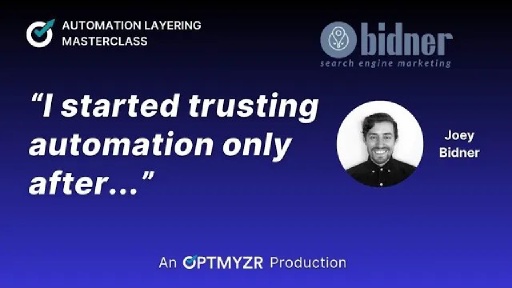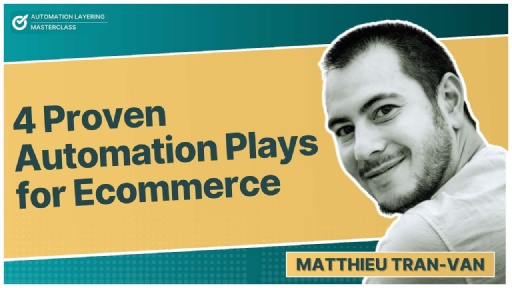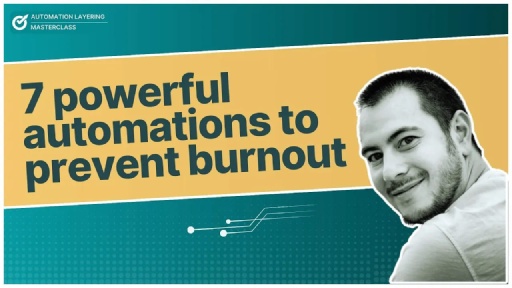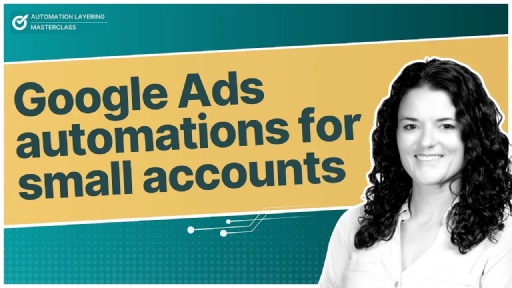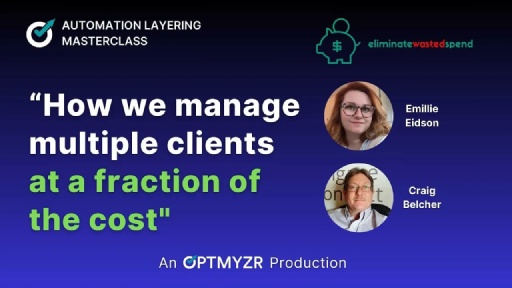
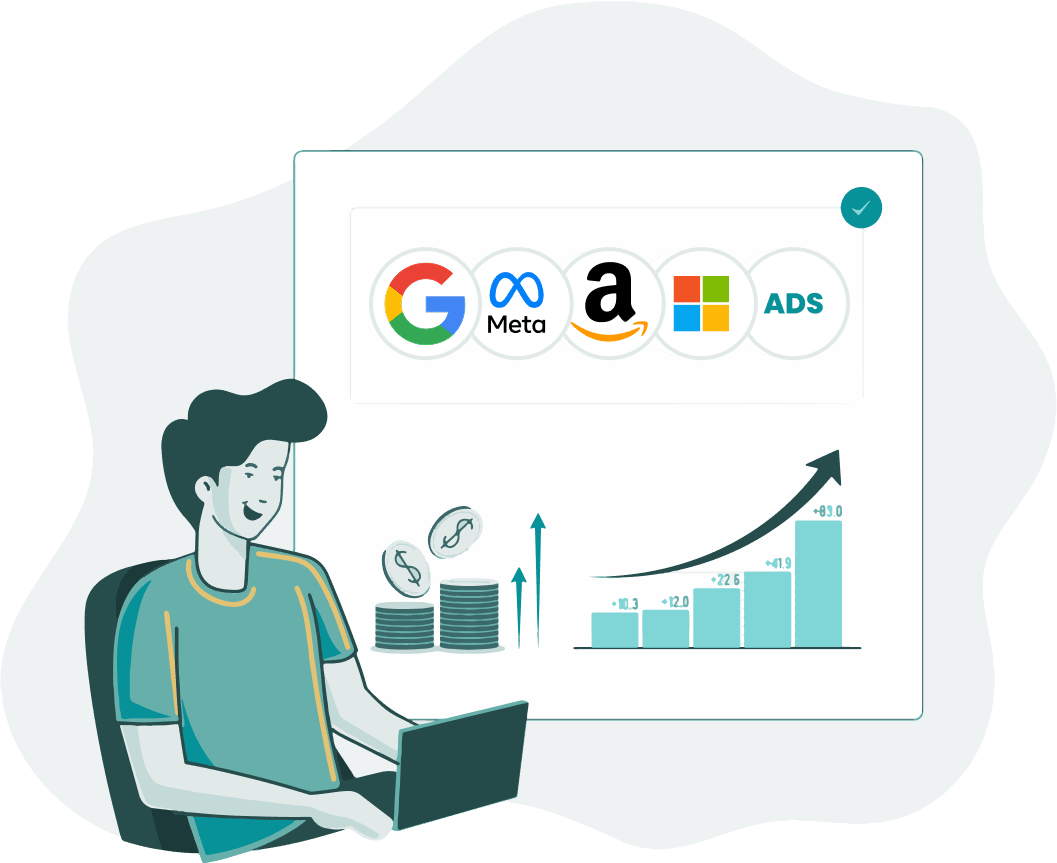
Episode Description
In this episode of Automation Layering Masterclass, you’ll learn how Jeppe Houbak from Web2Media found success with automated bidding during seasonal events using seasonality bid adjustments.
You will learn:
- How he used automation and target ROAS bidding strategy for a large range of ecommerce clients
- What happens when there is a flash sale and how does this conflict with a target ROAS strategy
- If you should stay with your current ROAS targets or increase them
- And, how it affects your bidding strategy
Episode Takeaways
Sudden changes during flash sales can throw automated bidding strategies like tROAS off balance. This leads to a fundamental challenge that many advertisers are likely to face: should you maintain your regular ROAS targets during sales events to maximize revenue and customer acquisition, or increase ROAS targets to protect profit margins?
Jeppe explains his team’s innovative approach to this challenge, including a precise formula for seasonality bid adjustments that accounts for multiple performance factors. He demonstrates how properly managed automated bidding can deliver significant traffic during promotional periods while maintaining consistent performance metrics.
1. How Jeppe used automation and target ROAS bidding strategy for a large range of ecommerce clients
Jeppe and his team often manage a large number of e-commerce clients using automation and tROAS bidding strategies. However, the problem with using Google’s automated bidding algorithms like tROAS is that they may lag, especially when there are sudden changes in conversion rates during short-term sales or seasonal promotions. If you don’t resolve this on time, the algorithm may end up bidding more aggressively, even when the event is over.
To counter this, Jeppe uses Google’s seasonality bid adjustment tool to inform the algorithm beforehand about any expected changes in conversion rates during promotional events.
He also uses a comprehensive formula to calculate seasonality adjustments based on three key factors:
Seasonality adjustment = Change to conversion rate + Change to average order value + Change in ROAS.
2. What happens when there is a flash sale?
When a short-term sale occurs without proper adjustment, the algorithm lags behind reality.
“What might actually happen is if we don’t take care, because the algorithm might be a little bit delayed to learn these new levels of conversion rates then we would see still an increase in revenue but also an increase in ROAS and then the days after, the algorithm again doesn’t really catch up.
So it will try to get too much traffic within a lower target ROAS before it ramps back up to the normal level. But this is not really ideal.” explains Jeppe
This is because multiple metrics change simultaneously during a flash sale. In such a situation, Jeppe’s formula would be instrumental since adjusting for the conversion rate alone wouldn’t be enough.
Jeppe also emphasizes the need to take a proactive approach. For instance, Web2Media predicts the likely impact of a flash sale by analyzing historical sales data. They use these insights to set the seasonality adjustment before the sale begins instead of waiting for the algorithm to account for it.
For a 20% discount flash sale, they would look at previous similar promotions and calculate:
- How much did conversion rates increase during those events
- How average order values changed
- The difference between the target and actual ROAS during those events
The sum of these three factors becomes the seasonality adjustment percentage they apply.
Jeppe specifically mentions that this approach works best for sales of 3 days or less. For longer promotions, the Google algorithm would eventually adapt, making the seasonality adjustment unnecessary or even counterproductive after a certain point.
3. Should you stay with your current ROAS targets or increase them during sales events?
Jeppe presents two distinct approaches to handling ROAS targets during promotional events:
- Maintain the same target ROAS (recommended approach)
- Maximizes revenue and market share during the sale
- Accepts slightly lower profit margins during the promotional period
- Can still increase total profit due to higher volume
- Increase the target ROAS
- Maintains consistent profit margins
- Results in less traffic and revenue
- Misses opportunity to acquire new customers
“When we have these seasonal events coming up and we use the seasonality bid adjustment I think there are two main approaches that need to be considered. Since most clients like to maximize the revenue during these seasonal events. So that’s where we have the same target ROAS.
You can still try to keep your profit margins at a certain level but then you would need to increase your ROAS targets during the promotional event and you would lose out on traffic and the potential revenue that is out there.” says Jeppe.
Ultimately, the decision to maintain or increase ROAS targets depends on your business priorities. For example, maintaining existing ROAS targets prioritizes acquiring new customers and market share over maintaining consistent margins. On the other hand, Jeppe notes that more ambitious clients typically prefer maintaining ROAS targets to maximize revenue opportunity.
4. How can increasing or maintaining ROAS impact your bidding strategy?
If you’re opting to increase your ROAS during sales, you may notice:
- More conservative bidding since increasing ROAS signals to Google’s algorithm that you need a higher ROI for your ad spend
- Less need for seasonality adjustments
- Reduced traffic and potential revenue
- More stable CPC
On the other hand, if you’re maintaining ROAS as recommended by Jeppe, you’ll notice:
- The need for proactive seasonality adjustments to account for the increase in conversion rates
- More aggressive bidding during auctions
You’ll also need to remove the adjustments as soon as the sale ends to prevent the algorithm from overbidding when conversion rates return to normal levels.
Tools & Resources
Episode Transcript
Frederick Vallaeys: Hello and welcome to another Automation Layering Master Class. My name is Fred Vallaeys and I’m your host. I’m also the CEO and co-founder at Optmyzr. Today we have Jeppe from Web2Media who’s joining us and he’s going to talk about what happens to target return on ad spend automated bidding when you have a seasonal event like a sale.
Now if you set a tROAS target and your conversion rate changes on the back end in a very drastic and sudden way, what happens to performance? What do you want to happen to performance and that’s where we got an expert to come and tell us what he saw and how he’s dealing with it. So let’s bring in Jeppe.
Jeppe welcome to the show. Thanks for sharing with us today.
Jeppe Houbak: Thank you very much and thank you for hosting me here.
Frederick Vallaeys: Hey so tell people a little bit about yourself, who you are, who Web2Media is, and where you’re calling us from today
Jeppe Houbak: Yeah sure my name is Jeppe Houbak. I am working here at Web2Media as a senior Google ads manager with a little more than four years of experience.
I’ve been working here with the same client during most of my time. So just a few changes to client portfolio, which is really nice because then I get to get closer to their business. Actually we like to value our clients more like partners and see ourselves as part of their marketing department rather than a supplier.
Frederick Vallaeys: Nice and where are your clients mostly based? You’re in Denmark right?
Jeppe Houbak: Yes we’re in Denmark and we have offices in Aarhus and Copenhagen. Most of our clients are also Denmark based. And then we have a few clients that are mainly working from outside Denmark but doing business in Denmark as well. And then quite a few of our clients have a an international focus too. We are about 80 employees and we are a full funnel marketing agency. Google ads is just part of our service.
Frederick Vallaeys: Great. So yeah if people want to reach out to Web2Media or you we’ll put the contact information on the the slides. Let’s jump into the topic here.
So we were looking at seasonal events right and so you guys are working with companies that have sales periodically. What happens to automated bidding during those periods? So let’s load up the slides you brought and take a look at those.
Jeppe Houbak: Yeah okay. So when we have these seasonal events coming up and we use the seasonality bid adjustment I think there are two main approaches that need to be considered. The one on the left is the one that I suggest since most clients like to maximize the revenue during these seasonal events. So that’s where we have the same target ROAS. Then on the normal days, we would like to see an increase in revenue and also an increase in market share. We are aware that it might affect our profit margins a bit but it can still increase the total profit after all.
Frederick Vallaeys: Right and that makes sense. So because, probably during most of the year, your target return on ad spend is based on an assumption of your margin for your product and between those two factors that determines the profitability of every click and every conversion. But during a sales event your margin is lower because you’re selling the product at a discount then you have less profit but because the price is so good you’re going to get more sales and more revenue.
Jeppe Houbak: Yeah exactly. That’s the idea behind it. I mean you can still try to keep your profit margins at a certain level but then you would need to increase your ROAS targets during the promotional event and you would lose out on traffic and the potential revenue that is out there.
Frederick Vallaeys: And that’s what you’re showing on the right side is that if you keep your profit margins then you’re still going to be profitable but you’re not going to get that big lift in revenue and potentially getting a whole bunch of new customers who may have never bought from you before and new customers obviously super valuable right because then you can put them on the email list and in a full stack marketing agency then there’s so many other things you can start doing with those people.
Jeppe Houbak: And because we mostly work with very ambitious clients, we normally see that the left strategy is the preferred one.
Frederick Vallaeys: Cool. Okay so let’s go get more revenue when we have these sales events. So what do we do? Do we just lower the price or is there something else we should be doing?
Jeppe Houbak: We would normally use the seasonality adjustment but just before jumping into that, this is what I would say we’d like to happen. That we stay at the same target ROAS but we see a spike in the revenue during these two days of our promotional event. This is what we’d like to happen right, that during the promotional events, during these two days of sales period we’d like to see that our target ROAS stays the same and that we see a spike in revenue.
Frederick Vallaeys: Yeah that’s the ideal way. Some nice lifts in revenue there so that’s what we’d like to see.
Jeppe Houbak: Exactly but what might actually happen is if we don’t take care, because the algorithm might be a little bit delayed to learn these new levels of conversion rates then we would see still an increase in revenue but also an increase in ROAS and then the days after, the algorithm again doesn’t really catch up. So it will try to get too much traffic within a lower target ROAS before it ramps back up to the normal level. But this is not really ideal.
Frederick Vallaeys: Yeah so basically what you’re saying there is that the algorithm from Google, the automated bidding, it’s going to notice that something unusual is happening during that sale. The conversion ratees may be going up, maybe the orders are changing and so it starts to change its bids. But then by the time it actually does that your sale has ended. So now it’s chasing something that doesn’t exist anymore and so that’s the problem and what you’re illustrating here.
Jeppe Houbak: That’s why we’ve been blessed with the with the seasonality bid adjustment tool from Google’s side. That’s like really good to to use when you can predict these changes to the conversion rate beforehand. And we tried to make a system to predict these increases in conversion rate based on previous promotions. So it could look like this where we have a 20% discount on a Saturday only for the outlet products. We have a Halloween sale coming up in the end of October and then of course the Single’s Day on the 11th of November.
So during these sales we see that the conversion rate might increase and this is based on previous sales periods as well. So we could just add this to our seasonality adjustment right. That’s the idea from the Google side.
Frederick Vallaeys: So right there you’re showing the change to conversion rate. Would you just straight up take that change to conversion rate as the seasonality adjustment? Is that what you’re saying?
Jeppe Houbak: No not exactly, but I think that’s the only option we have in the seasonality tool. We can only tell a predicted conversion rate. But there’s more to it. I think we can also add the the predicted change to average order value or basket size because at the end, the total conversion rate or the total conversion value is made of the amount of conversions we get and the average order value. And when there’s an increase in the order value then it also affects our ROAS.
Frederick Vallaeys: Alright so during a seasonal event we have a change in expected conversion rate but you’re saying there’s also change in the average basket value and ultimately all of these things play together and we might have a difference in ROAS performance. Let’s talk about that for a minute.
Jeppe Houbak: Yeah so if during the previous period, you are seeing a lower ROAS than your target then it’s important to take this into consideration as well. Otherwise we might just hit a lower ROAS than our target during the sales as well.
Frederick Vallaeys: Okay so you have these three factors that are impacting your performance and now the goal is to have a seasonality bid adjustment that takes all three factors into account and gets you to that point where you said let’s get more revenue, more sales but let’s keep everything else roughly the same. So what might that look like exactly?
Jeppe Houbak: It looks like this. So it’s a change to conversion rate plus change to average order value plus change in ROAS that then gives us us the total seasonality adjustment here.
Frederick Vallaeys: Oh interesting! So the math you’re doing is you’re literally adding up the values in those three columns and that is the seasonality adjustment that you set.
Jeppe Houbak: Exactly. Its because we’ve seen before that just adding the change to conversion rate is not enough.
Frederick Vallaeys: That’s brilliant. I love it when you share formulas. This is not just hypothetical, this is the actual math people. So column A plus B plus C equals your seasonality bid adjustment. So you’ve tested this right? Let’s talk a little bit about what kind of results you see from this.
Jeppe Houbak: Yeah we’ve tested it and for this client for example, we see quite significant impressions and traffic during these two three days of sales period and also we see that the clicks increase even more than the impressions meaning an increase in CTR as well.
Frederick Vallaeys: Nice so with these seasonality bid adjustments and these better prices you’re getting a tremendous increase in interest and activity and then what happens to the sales?
Jeppe Houbak: Yeah it goes up with the clicks luckily, meaning that at the end of the day we are quite close to reach our actual ROAS targets every single day no matter if we are having a normal day or a special sales day event
Frederick Vallaeys: Nice. So what you were worried about in the beginning, the tROAS algorithm chasing and not being able to hit the target, it seems like you’ve counteracted that.
Jeppe Houbak: Yeah exactly. So if we go back to this slide about what we might actually see and be scared about seeing then I’m quite happy with the results we’re seeing in order to achieve our goal. Just to repeat, the goal is to maximize the revenue within this target ROAS here.
Frederick Vallaeys: Nice. Well Jeppe and Web2Media, obviously amazing work on that and thank you for sharing it. Let’s talk a little bit about Optmyzr. I know you use Optmyzr but how does that fit into some of the things you do?
Jeppe Houbak: In general we’re really really happy with the tool. First of all I showed you just this one before, I think it will come up to the screen in a bit. This one here, when we see a change to the conversion value, when you see a change to the traffic what are actually the reasons behind this? Like this course analysis and it’s so good to use, to explain why do we see what we see.
Frederick Vallaeys: That’s right. The PPC investigator offers a really nice visualization to help understand what’s moving the needle in an account. Okay great! Love it! And then you can also of course use that tool historically. So I think one of the questions then that people might have is, well how do I figure out what is A, B, and C in the formula that we need to use? So what is my change in average order value? A tool like Optmyzr obviously makes that really easy to go back in time, but also to start to understand during that period when we saw a change, what was the main driver of that change, helping you make sure that it was actually the seasonality event and not something else happening.
Any final thoughts on doing this?
Jeppe Houbak: I think the final thought might be that even though Google says that they do take these upcoming seasonal events into consideration, like Black Friday, I would still use this one based on historical data, see what happens and then of course be very cautious during the day of what actually happens. I think it’s a really nice tool because you see the effect immediately when you add a seasonality adjustment to the account. Finally I would not do this if the sale is going on for more than three days I’d say.
Then the algorithm might ramp up but then you can use it the other way around as well if there’s a sudden decrease in the conversion rate to add a negative adjustment.
Frederick Vallaeys: That makes sense. Great! Hey well, thank you so much Jeppe for sharing everything you do with seasonality bid adjustments and how you deal with seasonal events and tROAS. I think this has been very helpful.
I hope you’ve enjoyed this episode and if you want to see more of these please subscribe on YouTube. We have automation layering masterclasses coming out all the time with other great experts but if you wanted to get a hold of Jeppe and Web2Media, we got the links right there at the bottom of the screen.
Jeppe, how should people get a hold of you? You’re on LinkedIn right?
Jeppe Houbak: Yes I’m on LinkedIn.
Frederick Vallaeys: Okay, Jeppe Houbak thank you again, thanks for watching!

